Each type of dermatitis has different symptoms and tends to occur on a different part of the body. It's possible to have more than one type at a time.
Dermatitis also is called eczema. Symptoms include itchiness, scaly skin, a swollen rash, oozing blisters and dandruff-like scaling. The condition is not passed from person to person.
Learn about the symptoms of common types of dermatitis.
Stasis dermatitis
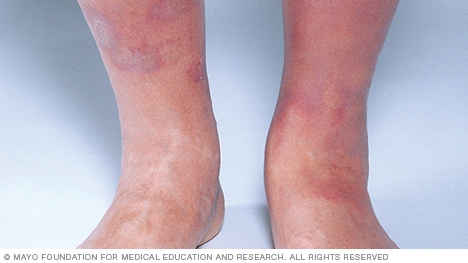 Stasis dermatitis
Stasis dermatitis
Common symptoms of stasis dermatitis are:
- Thickened, discolored skin on the ankles or shins.
- Itching.
- Open sores, perhaps with oozing and crusting.
- Swelling.
Stasis dermatitis occurs when varicose veins or other circulatory conditions cause fluids to build up in the lower legs. The swelling produces pressure beneath the skin and slows the flow of blood and oxygen to the skin.
Allergic contact dermatitis
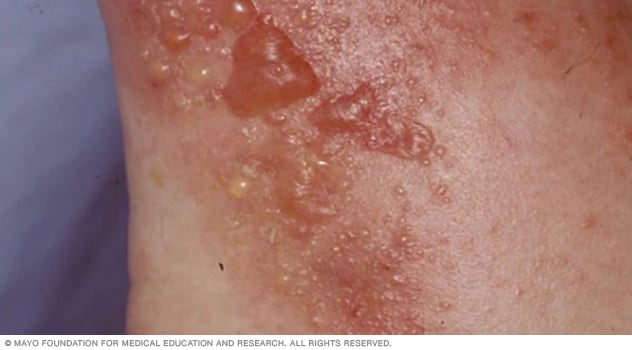 Allergic contact dermatitis
Allergic contact dermatitis
Common symptoms of allergic contact dermatitis are:
- Itchiness.
- Bumps and blisters, sometimes with oozing and crusting.
- Swollen rash.
Allergic contact dermatitis results when the skin touches substances that it's sensitive to. These substances are called allergens. The rash usually affects only the area that came into contact with an allergen. Common allergens are perfumes, personal care products, poison ivy, ragweed pollen and nickel, which is used in jewelry and other items.
Atopic dermatitis
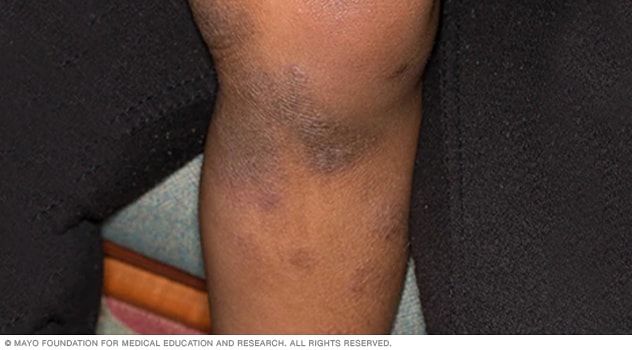 Atopic dermatitis
Atopic dermatitis
Common symptoms of atopic dermatitis are:
- Dry, cracked skin.
- Itchiness.
- Raw skin from scratching.
- Small, raised bumps, on brown or Black skin.
- Oozing and crusting.
- Thickened skin.
Atopic dermatitis also is called eczema. It often occurs in the folds of the elbows, behind the knees and on the front of the neck. It can flare and then clear up for a time.
Irritant contact dermatitis
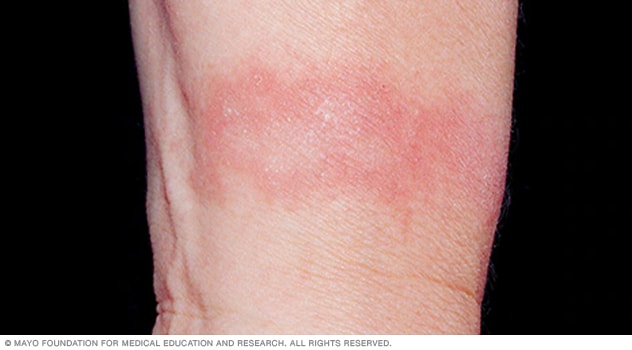 Irritant contact dermatitis
Irritant contact dermatitis
Common symptoms of irritant contact dermatitis are:
- Itchiness.
- Bumps and blisters, sometimes with oozing and crusting.
- Swollen rash.
Irritant contact dermatitis develops when the skin comes into contact with certain things that cause a rash. Irritant contact dermatitis is different from allergic contact dermatitis but shares some features. Some people react to strong irritants after just one exposure. Others may develop a rash after repeated contact with even mild irritants. Common irritants are solvents, bleach, soap and hair products.
Neurodermatitis
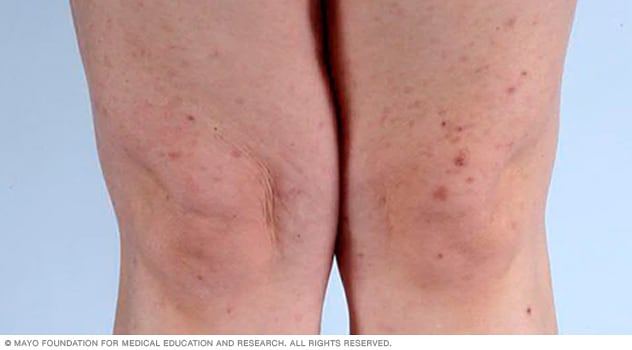 Neurodermatitis
Neurodermatitis
Common symptoms of neurodermatitis are:
- An itchy, scaly skin patch or patches.
- Thick, leathery skin.
- Raised, rough patches that are inflamed or darker than the surrounding skin.
Neurodermatitis also is called lichen simplex chronicus. The more you scratch, the more it itches. It often affects areas that can be reached for scratching — the scalp, neck, wrists, forearms, ankles, vulva, scrotum and anus.
Perioral dermatitis
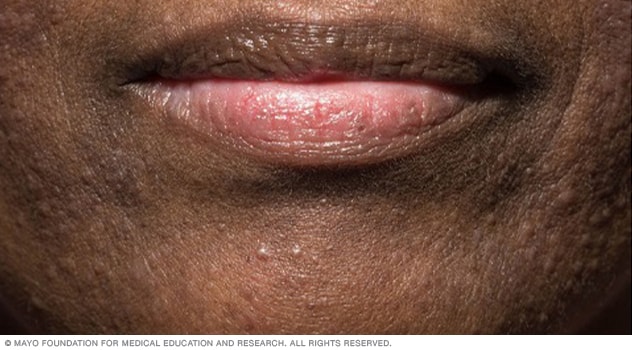 Perioral dermatitis
Perioral dermatitis
With perioral dermatitis, small pus-filled bumps appear around the mouth. This type of dermatitis also can affect the skin around the nose, cheeks and eyes. The exact cause of perioral dermatitis is unknown, but the corticosteroid medicine contained in some inhalers, nasal sprays and creams may play a role.
Seborrheic dermatitis
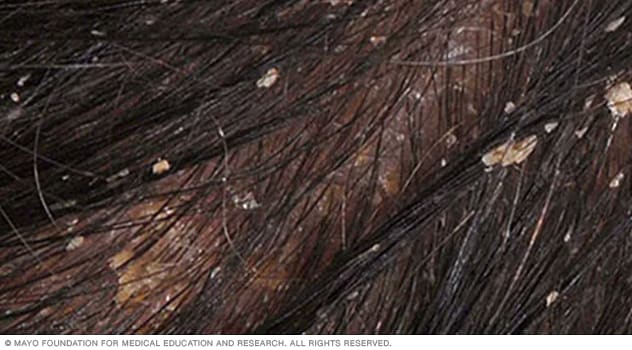 Seborrheic dermatitis
Seborrheic dermatitis
Common symptoms of seborrheic (seb-o-REE-ik) dermatitis are:
- Dandruff.
- Patches of greasy skin covered with flaky white or yellow scales or crust on the scalp, face, sides of the nose, eyebrows, ears, eyelids, chest, armpits or groin area or under the breasts.
- Itchy rash.
Seborrheic dermatitis is often found on oily areas of the body. It also can appear on the scalp as stubborn, itchy dandruff. In infants, this type of dermatitis is known as cradle cap.
Dec. 19, 2023
- AskMayoExpert. Seborrheic dermatitis. Mayo Clinic; 2023.
- AskMayoExpert. Atopic dermatitis. Mayo Clinic; 2022.
- AskMayoExpert. Contact dermatitis. Mayo Clinic; 2023.
- AskMayoExpert. Perioral (periorificial) dermatitis. Mayo Clinic; 2023.
- Lichen simplex chronicus. Merck Manual Professional Version. https://www.merckmanuals.com/professional/dermatologic-disorders/dermatitis/lichen-simplex-chronicus. Accessed Nov. 6, 2023.
- Kelly AP, et al. Atopic dermatitis and other eczemas. In: Taylor and Kelly's Dermatology for Skin of Color. 2nd ed. McGraw Hill; 2016. https://accessmedicine.mhmedical.com. Accessed May 9, 2022.
- Kelly AP, et al., eds. Seborrheic dermatitis. In: Taylor and Kelly's Dermatology for Skin of Color. 2nd ed. McGraw Hill; 2016. https://accessmedicine.mhmedical.com. Accessed Nov. 6, 2023.
- Dinulos JGH. Atopic dermatitis. In: Habif's Clinical Dermatology. 7th ed. Elsevier; 2021. https://www.clinicalkey.com. Accessed Nov. 7, 2023.
- Dinulos JGH. Contact dermatitis and patch testing. In: Habif's Clinical Dermatology. 7th ed. Elsevier; 2021. https://www.clinicalkey.com. Accessed Nov. 7, 2023.
- Dinulos JGH. Psoriasis and other papulosquamous diseases. In: Habif's Clinical Dermatology. 7th ed. Elsevier; 2021. https://www.clinicalkey.com. Accessed Nov. 6, 2023.
- Stasis dermatitis. Merck Manual Professional Version. https://www.merckmanuals.com/professional/dermatologic-disorders/dermatitis/lichen-simplex-chronicus. Accessed Nov. 7, 2023.